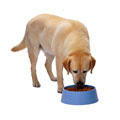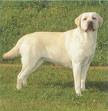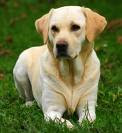
When I write of a "well-rounded" black Labrador puppy, you may immediately picture a round, roly-poly black puppy. That is not what we normally mean by the term, of course.
Understanding black Labrador puppies begins by grasping the fact that a well-rounded black Labrador puppy is one that has learned to get along with other dogs and with family members (including other pets). It is a puppy that has bonded with his "pack" and fits in well. It has been socialized - but how do you socialize a black Labrador puppy?
Socializing the Black Labrador Puppy
All dogs are social creatures, but few are as social as a black Labrador puppy. A black Labrador puppy loves attention, and wants to get it from everyone and everything. A black Labrador puppy does not want to share, however, and must learn that every member of the "pack" shares. He must learn how to respond to both human and animal members of his new pack.
Understanding black Labrador puppies involves 7 simple steps that help puppies become well-rounded.
1. Puppy Pats
Your black Labrador puppy needs to be patted, touched, and caressed. Most people do this instinctively from the time they get the puppy. Children, especially, touch the puppy in every possible place they can. The more children there are, the more puppy pats your black Labrador puppy will receive. Even if yours is a gun dog, and children are not playing with it, it still needs puppy pats. Let it feel your hand on its ears, its nose, and its paw pads. Get your black Labrador puppy accustomed to being touched and patted. It will help him fit into his new life. While you're at it, teach children how to treat the puppy.
2. Puppy Playtime
It is important that you and your black Labrador puppy have several playtimes each day. If possible, give him at least one in the morning and one in the evening, as this will establish a pattern for future exercise times. Teach your black Labrador puppy that you are his friend. Play fetch. Take a toy away, teaching the importance of sharing. Do not let him take it back in an aggressive manner. Hide a toy and let him hunt it.
3. Puppy Rolling Game
Every black Labrador puppy needs to be involved in frequent bouts of the puppy rolling game. This game shows the puppy that his position in your pack is one of submission. When playing with your black Labrador puppy, roll him on his side now and then. Hold him there as you silently count to 10. When you reach 10, remove your hand and let the puppy get up. If he struggles while you're holding him, do not let go. You must not let your black Labrador puppy overpower you, or he will believe he is the pack's dominant member.
4. Share-a-Puppy
A big part of understanding black Labrador puppies is recognizing that they need a wide circle of acquaintances. When you get your pup, note his age in a notebook. Subtract it from 24 weeks. If your puppy is 8 weeks old, you would subtract 24 - 8 = 16. In those weeks (whatever number you wrote), you need to share your puppy with at least 100 new people. If you wrote 16 weeks, set a goal of having your puppy meet 6-7 new people each week. Keep track so you know it is happening. Simply have strangers hold your black Labrador puppy, and touch it. Hand it back and forth carefully so it does not fall.
5. Share-a-Meal
A black Labrador puppy can quickly learn to be protective of his food dish. If left to natural instincts, he may become hostile when others come near his bowl. To avoid this, share a meal by sitting or standing close to the bowl when the pup is eating. Have other family members do the same. Teach your black Labrador puppy that his food is safe even when someone is very near.
6. Puppy Home School
From the time you get your black Labrador puppy, teach him every day. He is old enough to learn basic commands such as come; down; drop it; leave it; and sit. Avoid yelling at the puppy or punishing it. There are good Labrador training courses available on the Internet. Order one and use it faithfully.
7. Puppy Support Group
Please understand that a black Labrador puppy needs the constant support of everyone in his home. Life is full of exciting things, as well as frightening things. When a garbage truck comes banging down the street, he will tuck his little tail between his legs and run for cover. What do you do. You - and everyone else present - act as though nothing happened. Your black Labrador puppy will notice that he is the only one running. He will soon decide that, if no one else is afraid, the sound of garbage trucks is not important.
Understanding black Labrador puppies is an ongoing process, but these 7 steps will give you a good start.
Source-www.articlesbase.com
Author- Anna Hart
Monday, June 4, 2007
Understanding Black Labrador Puppies
Posted by Life Is Beautiful at 2:15 AM 0 comments
Labels: black labs
Thursday, May 31, 2007
Thursday, May 24, 2007
Biscuit Recipe For Your Lab

Ingredients:
3 1/2 cups unbleached flour
4 teaspoons salt
2 cups whole wheat flour
1 envelope active dry yeast
1 cup rye flour
1/4 cup warm water
2 cups bulgur
3 cups chicken broth
1 cup cornmeal
1 egg, slightly beaten with 1 teaspoon milk
1/2 cup instant nonfat dry milk
Steps:
Heat oven to 300 degrees F.
Mix flours, bulgur, cornmeal, dry milk powder and salt with a wooden spoon in a large bowl. Dissolve the yeast thoroughly in warm water at 110 to 115 degrees F in a glass measuring cup. Add this to the dry ingredients. Add chicken broth to the flour mixture. Stir until dough forms.
Roll out dough until it is 1/4-inch thick. Using a cardboard pattern or dog biscuit cutters, cut out bone shapes from dough. Place biscuits on a greased cookie sheet. Brush dough with the egg glaze. Bake bones for 45 minutes.
Turn oven off. Biscuits should remain in oven overnight to harden.
Posted by Life Is Beautiful at 2:51 AM 0 comments
Labels: Food
Wednesday, May 23, 2007
How To Read Dog Food Labels?

By learning how to read a label, you can learn a great deal of information about the food you are feeding your pets. You can even learn how to compare one food to another and choose the one best suited for your cat.
As with human food labels, pet food labels are strictly regulated by the federal government, the Food and Drug Administration and the Department of Agriculture, and must follow stringent guidelines. Pet food labels are typically divided into two separate sections: the principal product display and information about the food.
Principal Display – Product Name
This part of the pet food label contains the brand name of the food as well as the specific food or formula contained in the can. It lists which meat is primarily used in the food and may indicate for which age group the food is intended (growing, maintenance, adult). The product weight, in grams and ounces, is also included.
The principal display also includes the type of animal the food is meant for – dogs or cats.
How the product is listed on the label is also strictly regulated. In order to call something "Salmon Cat Food," at least 95 percent of the product must be the named meat, without counting the moisture content. If the moisture content is included, at least 70 percent of the product must be the meat listed. If the name has a combination of meats, such as "Chicken and Salmon," the two products together must be 95 percent of the product with the first ingredient listed more prevalent.
If the amount of the meat is over 25 percent but less than 95 percent, a qualifier must be added. The word dinner is a commonly added qualifier but platter, entrée, nuggets and formula are also common. Also, just because this product name says "chicken formula" doesn't mean beef or fish are not added. Check the ingredient list to find out which meats are also included.
Another rule regarding product name is the newly approved use of "with." In pet food such as "Cat Food with Chicken," since the word "chicken" follows "with," that food must have at least three percent of the food as chicken. This wording can fool some people. "Tuna Cat Food" is very different than "Cat Food with Tuna." The first has 95 percent tuna. The second only has three percent tuna.
Informational Section
In addition to displaying the product name, brand name, weight and intended species, the pet food label also includes a more complex section. The informational section contains a list of ingredients, the guaranteed analysis, feeding instructions and nutritional adequacy claim. This is the part of the label that is most important when comparing different foods and determining the nutrients in the product.
Guaranteed Analysis
This section of the pet food label lists the amounts of each ingredient contained in the food. Typically, the minimum amount of the ingredients is listed and not always the exact amount. When comparing one product to another, you must take moisture content into account. The ingredients should be compared on a dry matter basis. This means that if 82 percent moisture is present in the food, the remaining items comprise 18 percent of the diet. The minimum values listed for each ingredient (besides water) should be divided by 0.18 in order to get a dry matter amount. Now two products can be compared fairly.
Protein - The first item most people look at is the protein. Let’s say that 26% is listed on the bag. This tells you almost nothing, as it is listed as crude protein. This is the combination of digestible and indigestible proteins. It is possible that of the 26% listed, 15% may be indigestible, and therefore useless. Indigestible proteins may consist of horse’s hoofs, hair, feathers, beaks, rice hulls, inferior corn or chicken, etc.
It is illegal to place the actual amount of digestible proteins or the quality of ingredients on a dog food bag. This levels the playing field, and makes the venture more profitable for large companies.
Ash – The lower this figure, the better. Ash is created by several factors, such as the quality of the meat used, and the cooking methods. Take, for example, the majority of chicken used in dog foods today. These chickens are used as egg layers, until the quantity of eggs begins to decline. These hens are fed less and less on a daily basis, until they sometimes die from lack of nutrition. This not only leads to a breakdown of proteins, but a high ash level as well. Cooking imparts its own level of ash, therefore making cooking methods critical. Low ash chicken is the best, but used by very few dog food companies.
Moisture
Some moisture is necessary to keep the kibble edible. 10% is an accepted norm. More than that and you are buying expensive water.
Ingredients
Chicken- Chicken makes the best dog foods, as it is the most tasty and nutritious.
Lamb - Lamb is not desired by canines, due to the overpowering scent. It is usually necessary to mask lamb with sugars or flavors. Lamb is used as an ingredient to attract humans, not dogs.
Corn - If corn is the first ingredient on your bag – Consider returning it.
Rice hulls, peanut shells, etc. These are fillers, and not desirable due to their abrasive nature and lack of digestibility
Let’s start with the main source of meat. Take, for example, fresh chicken, which sounds healthier than chicken meal at first listen. Keep in mind that the ingredients are listed in order of weight at the time of mixing. Fresh chicken is 70% water, which gets cooked out during the manufacturing process. However, as the water adds weight, it is considered the first ingredient. Properly placed, it would really come in fifth or sixth on the list.
Chicken Meal is chicken with the water removed. When it is listed as the first ingredient, it stays in first place all the way through the process. Therefore, it is better to have chicken meal in a food. Fresh chicken is good in high quality treats.
Beet pulp (sugar removed) – This is an excellent product to help keep the intestinal tract clean.
Feeding Instructions
Each pet food lists how much of the food to feed per day. It is up to you to decide whether to feed as one meal or split into several throughout the day. The feeding instructions should be considered suggestions and not rules. A variety of factors will determine if your specific pet needs more or less of the food.
Nutritional Adequacy Claim
This section of the information area lists the life stage for which the food is made, such as "for maintenance," "for growth" or "for all life stages." If the pet food follows the guidelines set forth by the Association of American Feed Control Officials (AAFCO), the label will include a statement that says the food provides complete and balanced nutrition for a particular life stage. It will also list if the food is meant as a treat or a supplement and should be fed in combination with other foods.
Posted by Life Is Beautiful at 4:37 AM 0 comments
Saturday, May 19, 2007
Lazy Bone Egg Dog Pudding Recipe

Ingredients:
2 raw eggs
2 cups milk
1 cup chicken stock (look up directions for preparation)
4 hard boiled eggs
12 slices bread, broken into strips
2 cups chopped cooked chicken
4 tablespoons non salted butter
Ground black pepper
Pinch paprika
Steps:
Heat oven to 175 C. and grease a baking dish
In a mixing bowl, mix the raw eggs, milk, chicken stock, salt and pepper to taste, beat all this well. Stir in the chopped hard boiled eggs. Put the bread and the chicken in the baking dish and pour the egg mixture over it all, dot it with butter and sprinkle a bit of paprika over it. Bake for about half an hour or until all the liquid has been absorbed and the pudding is slightly browned around the top and the edges. Cool before serving.
Posted by Life Is Beautiful at 8:20 AM 0 comments
Labels: Dog treats
10 Good Things Every Labrador Should Know

1. The garbage men are not stealing our things.
2. Don't stand up suddenly, when you're under the coffee table.
3. Shake your coat, before going into the house.
4. Don't lick a cup, when there is hot tea in it.
5. When you hear a doorbell: don't bark. It's on TV.
6. No stealing of underwear and running with it in the backyard.
7. Do not roll in the dirt after bathing.
8. Pushing your nose in someone's crotch, is not an acceptable welcome greeting.
9. Don't eat paper handkerchiefs or diapers.
10. No rolling over dead animals, just because they smell so good.
Posted by Life Is Beautiful at 8:12 AM 0 comments
Sunday, May 13, 2007
Major Health Concerns For Labrador Retrievers

1. Labs are somewhat prone to hip and elbow dysplasia, especially the larger dogs,[citation needed] though not as much as some other breeds.[24] Hip scores are recommended before breeding.
2. Labs also suffer from the risk of knee problems. A luxating patella is a common occurrence in the knee where the leg is often bow shaped.
3. Eye problems are also possible in some Labs, particularly progressive retinal atrophy, cataracts, corneal dystrophy and retinal dysplasia. Dogs which are intended to be bred should be examined by a veterinary ophthalmologist.
Other disorders
Labs are sometimes prone to ear infection, because their floppy ears trap warm moist air. This is easy to control, but needs regular checking to ensure that a problem is not building up unseen. A healthy Lab ear should look clean and light pink (almost white) inside. Darker pink (or inflamed red), or brownish deposits, are a symptom of ear infection. The usual treatment is regular cleaning daily or twice daily (being careful not to force dirt into the sensitive inner ear) and sometimes medication (ear drops) for major cases. As a preventative measure, some owners clip the hair carefully around the ear and under the flap, to encourage better air flow.
A Labrador that undertakes significant swimming without building up can develop a swelling or apparent kink known as swimtail. This can be easily treated by a veterinary clinic and tail rest.
Obesity
Labs are often overfed and are allowed to become overweight, due to their blatant enjoyment of treats, hearty appetites, and endearing behavior towards people. Many Labs are kept by busy families in urban settings, which often leads to an inactive dog, also a contributing factor for many overweight Labs. A healthy Lab should keep a very slight hourglass waist and be fit and light, rather than fat or heavy-set. Excessive weight is strongly implicated as a risk factor in the later development of hip dysplasia and diabetes, and also can contribute to general reduced health when older. Arthritis is commonplace in older, overweight Labs.
Posted by Life Is Beautiful at 8:17 AM 0 comments



